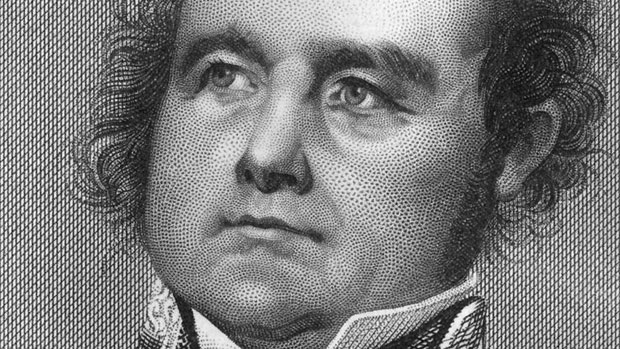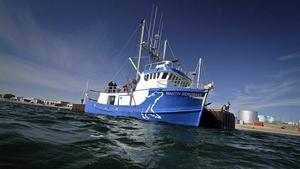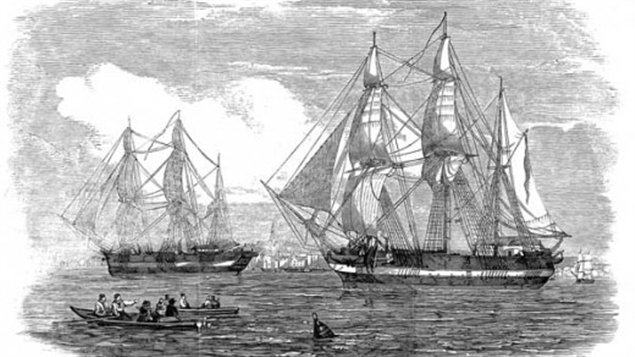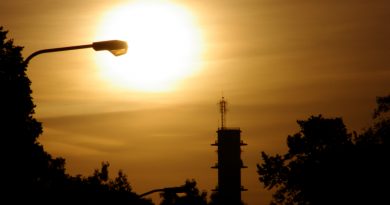Search for lost Franklin ships launched in Canada’s Arctic
 Arctic sovereignty fuelling the quest for ships Erebus and Terror, observers say
Arctic sovereignty fuelling the quest for ships Erebus and Terror, observers say
In a joint alliance of several government agencies and private interests, the Canadian government today launched its largest search yet for the lost ships of Sir John Franklin’s doomed 1845 quest for the Northwest Passage.
Since the Erebus and Terror disappeared nearly 170 years ago in the Arctic waters off what is now Nunavut, their saga has become much more than a Victorian horror story, with its touches of cannibalism, dashed dreams and death in the unforgiving North.
“Erebus and Terror are probably or arguably the most important exploration wrecks that have not been found, in the sense that the Franklin expedition is an enduring mystery,” says author John Geiger, whose 2004 book Frozen in Time, co-written with Owen Beattie, probed the fate of the failed 19th-century polar mission.
This year’s search, led by Parks Canada, is the fourth government-led expedition over the past five years, and is by far the biggest, involving a much larger alliance of federal departments and other public and private interests. A previous large-scale search for the Franklin ships was launched by National Defence in 1967 as part of Canada’s centennial.
Among today’s participants, there are some like the Canadian Hydrographic Service that are contributing while completing other tasks. The CHS is already in the area charting the Arctic sea floor, something that is gaining significance as retreating ice opens northern waters to increased ship traffic.
The Arctic Research Foundation, a private, non-profit group, is also contributing a research vessel, the Martin Bergmann.
A converted fishing trawler, it is in large part responsible for the expansion of the search from last year’s one-week effort to this year’s mandate of five or perhaps six weeks. It will try to take in two search areas, one more northerly and one more southerly, near King William Island.
‘Incredible chapter in Canada’s history’
As a measure of the at least symbolic importance of this quest, Prime Minister Stephen Harper announced the resumption of the search today in Cambridge Bay. CBC News is on the search ships and will provide full coverage of the search throughout the five or six weeks that it is underway.
Andrew Campbell, Parks Canada’s vice-president of external relations, says the Franklin story represents an “incredible chapter in Canada’s history.”
But it also presents something of a conundrum. While the lost ships have been declared a national historic site, a designation that falls under the purview of Parks Canada, their precise location is unknown.
The idea of trying to find the ships that set out in quest of the Northwest Passage is nothing new: the British admiralty sent several missions, including a large one under Sir Robert McClure in 1850, to try to find Franklin.
Those efforts, says Campbell, had an additional significance as they ushered in a new chapter in the exploration of the Canadian Arctic.
“Without Franklin, and without McClure searching for the remnants of what was left of Franklin or potentially any of his crew, we wouldn’t have the Northwest Passage mapped during that period.”
Today, of course, the search for Franklin’s ships have another significance. Federal officials have spoken as early as 2008 about the importance of this search in terms of asserting Canada’s northern sovereignty.
New technology
This year’s expedition is not only being bolstered a range of new participants, but also by new technolgy and bigger gear.
The Martin Bergmann’s role in the search is expected to begin later this month or in September, after engine repairs are completed.The Canadian Coast Guard icebreaker Sir Wilfrid Laurier will support the search for two weeks.
New technology in the form of an autonomous underwater vehicle from the University of Victoria will also be part of the quest.
Interest in the search from other federal departments has been growing, and Marc-André Bernier, Parks Canada’s head of underwater archeology, says the Franklin project “really fits into departments trying to work together … to get the most out of everybody’s resources.”
Campbell says the cost to Parks Canada for the search this year is about $270,000 and, of course, comes on the heels of federal plans to cut department spending, including Parks Canada, by a total of $5.2 billion a year by 2015. Previous Parks Canada search efforts have been in the annual range of $100,000 to $200,000.
 ‘Absolutely an agenda’
‘Absolutely an agenda’
For Geiger, who is now the editorial board editor of the Globe and Mail, the government’s willingness to invest in the Franklin search signals that there’s far more going on with this project than simply an interest in finding two old ships.
“There’s absolutely an agenda,” he says. “I can’t imagine a government investing the kind of resources, scarce resources, in pursuit of historical knowledge. It’s virtually unprecedented, so clearly there’s more at play here than simply a senior government official’s interest in history or a historic puzzle.”
As Geiger sees it, the government wants “to assert Canadian sovereignty over the Arctic islands and also the waterways,” something that becomes more significant as the effects of climate change are opening up the North to more foreign vessels.
“This is an attempt by [the Canadian government], I think, to assert national interest, to excite national interest, to rally Canadians around a sense of ownership and investment in that part of the world.”
Adriana Craicun, a professor at the University of California in Davis who has studied and written about the Canadian Arctic, sees the withdrawal of the sea ice and the changing nature of the Arctic as being among the most important issues a Canadian government will have to grapple with in the future.
“A Franklin ship located in the Northwest Passage is a relatively minor piece of legal ammunition,” she says. But it is also “probably the most valuable cultural, historical, international-scale material” that a Canadian government can point to in asserting a claim for greater control over the Northwest Passage.
Mind you, if one or both wrecks are found, searchers will have overcome significant odds.
While retreating ice has opened up the northern search area in recent years, any search is still at the mercy of a relatively short open-water season and, in particular, the wind.
“One of the primary limiting factors for us is not daylight or darkness or rain or snow or these kinds of environmental factors,” says Ryan Harris, the Parks Canada marine archeologist leading the search efforts from Nunavut.
“It’s wind, because the wind tends to stir up the ocean, create the waves.”
Boats pitch around in the waves, making it difficult to get a clear image from sonar towfish emitting acoustic pulses reverberating off the sea floor. The autonomous underwater vehicle from the University of Victoria, however, can slip under the waves and do its work in conditions that would normally rule out sonar scans.
“Hopefully that’s going to expand once again our total survey window,” says Harris.
A very bad ending
At the heart of the search, however, is the mystery of just what did happen to the two ships under the command of Franklin, after he set out from England in 1845 to find the Northwest Passage and its promise of a faster trade route to China.
Canadians, from their earliest school days studying the great explorers, know in broad strokes how it turned out: very badly.
The ships were trapped in ice in 1846 and abandoned two years later; Franklin and all his 128 men eventually died. Few traces have been found, although three corpses were exhumed on Beechey Island in the 1980s.
“There are just a tremendous number of enduring questions about the Franklin expedition,” says Geiger, whose book with anthropologist Beattie described those exhumations.
Research described in Frozen in Time has also shed some light on just what might have happened, including the role lead poisoning from the tins containing the sailors’ food may have played in their demise.
But there are so many other questions.
“Why did [the sailors], when they deserted the ships, why did they march in the direction they marched? Why did so many of the officers die relative to the ordinary seamen aboard the ships before they were deserted?” wonders Geiger.
There is also the spectre of cannibalism by Franklin’s sailors hanging over the story, something that sparked outrage at the time when it was reported in Victorian England — no less a voice than author Charles Dickens suggested such actions by civilized British men would be impossible. Evidence later suggested otherwise.
A story of Canada
Today, Geiger sees any discovery holding the potential to stimulate interest in Canadian history.
“This is Canadian history. It was a British expedition, but this is really the story of the discovery of Arctic Canada.
“The expeditions in search of Franklin, initially in relief of Franklin, and in search of the remains of the expedition really did map much of the Arctic archipelago.”
While the search parties — some instigated by Franklin’s very determined wife, Lady Jane — were looking for Franklin, they also made significant contact with the Inuit, whose oral histories and stories have played a significant role in determining where today’s ship search will focus.
Bernier says one of the most important facets to the current search is the opportunity to validate some of the Inuit testimonies.
Aboriginal heritage
Craicun sees the aboriginal heritage connected to the Franklin story having special significance, particularly in how a national historic site recognizing the Erebus and Terror might be created.
“How a site devoted to a failed British expedition, whose architects sought to demonstrate the superiority of British science over Inuit knowledge, will accommodate the complex entanglement of Inuit communities on the one hand and national interests on questions of Canadian Arctic sovereignty on the other will be the most interesting aspect of any Franklin discovery,” she wrote in a piece published in the Literary Review of Canada in May.
Bernier hesitates to lay odds on whether one or both ships will be found. Eventually, he suggests a 45 to 50 per cent chance, up from about five per cent that was suggested last year.
“If we do this over a couple of years, then we’ll cover all the territory where these ships can be, so if there’s any remains, hopefully we’ll be able to see them.
“We have the tools to find them, we have the people and the trained people to find them, and now we have the time to find them, so the odds are better than ever. That’s what I can say.”
Related Link:
Searching for Franklin, CBC News Special Report
For more northern stories from CBC News, click here




